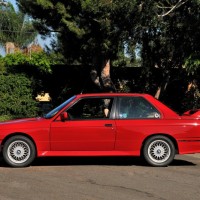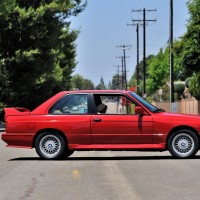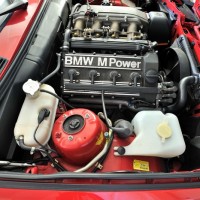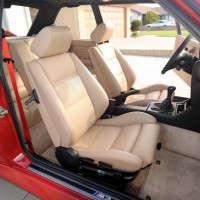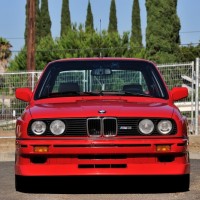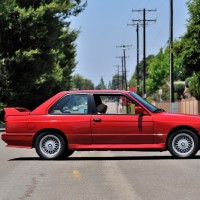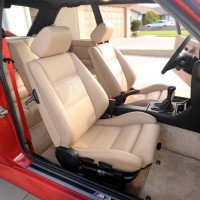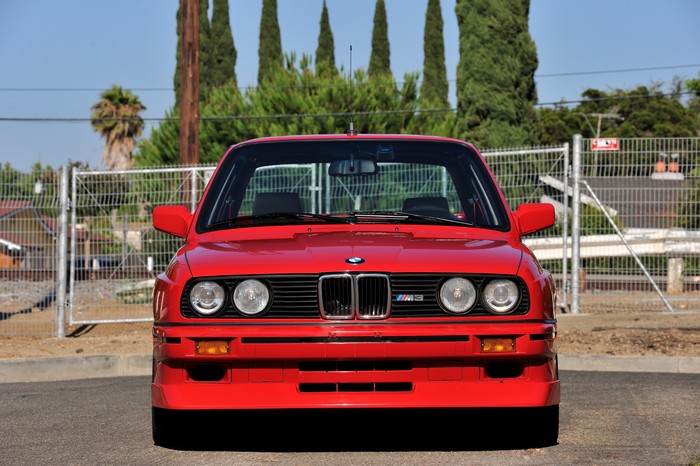
The tightly wound, high-revving 4-cylinder engine was developed in the mid-1980s by Paul Rosche, technical director of BMW M GmbH. Rosche chose to use an existing 4-cylinder engine — and the head from the iconic M1 — after chopping off two cylinders.
Rosche chose the 4-cylinder block rather than the 6-cylinder because the larger crankshaft would take longer to vibrate in the 4-cylinder engine. The new engine was given the designation S14. The crank was stout enough in the S14 to sustain revs at 10,000 rpm, which was much greater than the 6-cylinder engine.
Amazingly, Rosche developed the first 4-cylinder prototype in just 14 days, hence the engine name S14.
Other differences from the 6-cylinder 3 series included five-lug wheels as opposed to four lugs. There are box-flared wheelarches to accommodate the larger wheels, a large front air dam with side aero package and an extended C-pillar to help air flow to the added large rear wing.
All this is why some refer to this car as the “boy racer.” That’s okay, as there is real power and performance under the glitz.
The M3 features special brake calipers and rotors on all four wheels and a Getrag 5-speed gearbox. The engine performance was — and still is — stunning. The U.S. version of the 2.3-liter engine hit 62 mph in 6.9 seconds — with a top speed of 143 mph.
This same engine, which is what you’ll find in most M3s living in the United States, puts out 192 horsepower at 6,750 rpm and tons of torque. These are outstanding numbers even today, more than two decades later.
The 197-hp engine in the much-coveted Sport EVO version topped out at more than 150 mph.
Go ahead and say “boy racer” now. The car was — and still is — an autobahn stud.
A driver’s car
All this equipment made for a very successful rally and race car. It’s also a wonderful driver as a sports car. In 2007, Automobile Magazine named the M3 as one of the Top Five greatest driver’s cars of all time.
This car rewards the driver with crisp turn-ins and fabulous brakes. A vibration runs through this car, the mirror shakes, the shifter vibrates and the throttle feels like that of a race car.
The M3 still runs with the newer high-horsepower cars of today with no problem in the hands of a competent driver. Because of its excellent balance and horsepower-to-weight ratio, higher entry speeds and exit speeds are the reward. This car puts a huge smile on my face every time I drive it.
The M3 was introduced to the United States during the 1988 model year, and it sold out in no time. The car was not cheap, at a base sticker price of $34,950 plus dealer cost.
Sales slowed during the 1989 model year — some cars stayed on the dock — thanks to the much higher sticker price than the standard 3 Series BMW. Because of this, there is a small group — mine included — of 1989 cars titled as 1990 cars. In addition, these cars have some cost-cutting measures, such as no opening rear windows, heated seats or airbags. The real 1990 cars have airbags.
Pure joy on the road
The E30 M3 set the bar for a race car that could be sold as a street car; no other car re-creates the handling and pure joy of driving that comes from the E30 M3. For me, it’s the peak of the mountain, and everything else is just not quite as good. I, like most SCMers, have a few cars, but the M3 is my favorite to drive.
The SCM Pocket Price Guide gives the E30 M3 a collectibility rating of “C” and values them in the $12,000 to $22,000 range. I’m guessing these are pedestrian cars, as I see plenty of M3 sales in the mid-$20k range with great regularity for good cars. Really good, low-mileage, unmolested cars sell into the $30k range.
I know I would not even consider a number under $20,000 for my car. Publisher Martin can attest to that, as he has tried to buy my car, which still puts a smile on my face.
Not a commuter car
This is not an everyday driving car. The ride is slightly harsh, the steering is heavy, and it’s loud. The mechanicals are complicated, and you can expect to dish out $15,000 for a typical rebuild.
Like many other special cars, this one attracts a hard-core group of followers. The Special Interest Group (E30 M3 SIG) is a very active worldwide forum that is helpful to any potential owner. And, of course, there’s the BMW Club of America.
The E30 M3 was produced in three models: the base 2.3-liter version, the Cabriolet, and the much-sought-after Sport EVO with its larger 2.5-liter engine. Both the Cabriolet and the Sport EVO did not make it to the United States in their initial runs. Since then, a few have made it over here. They cost the moon and the skies, but, yes, I want one of them.
You can call me a boy racer anytime. ♦
